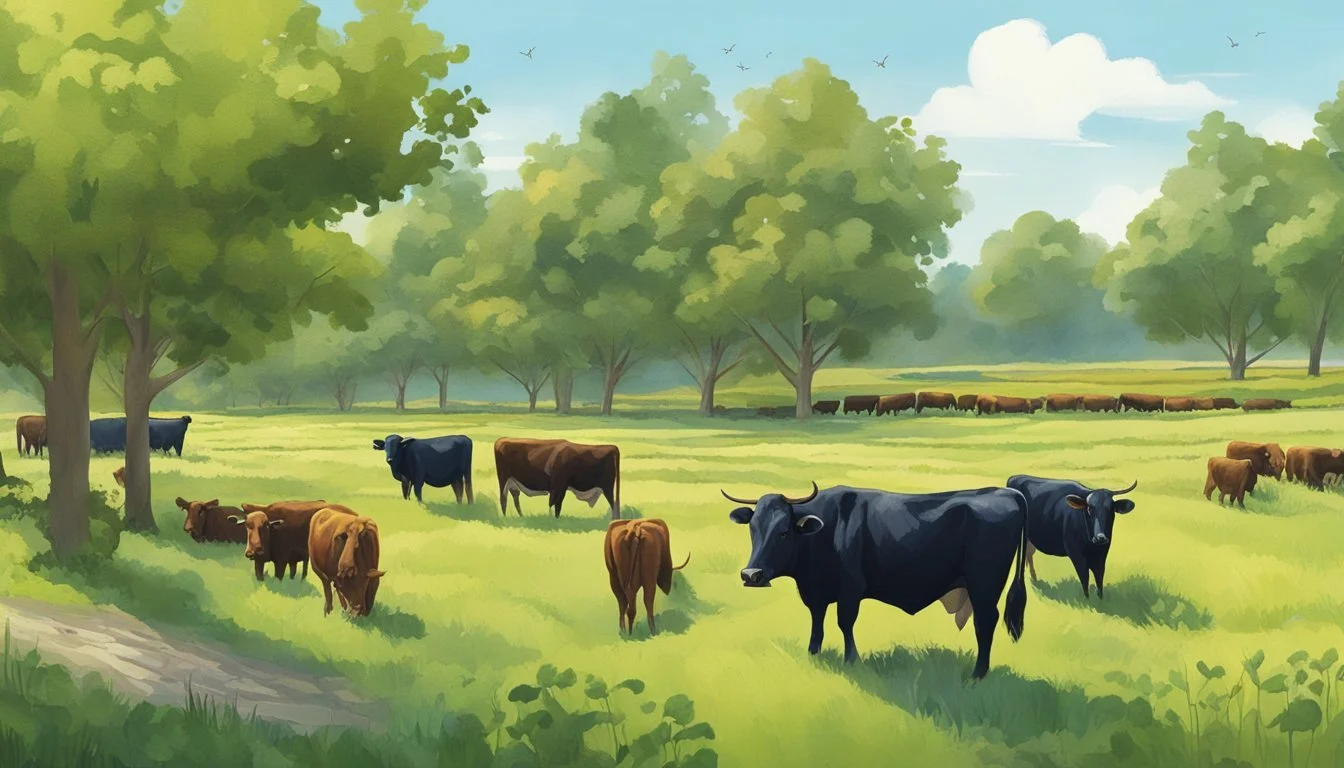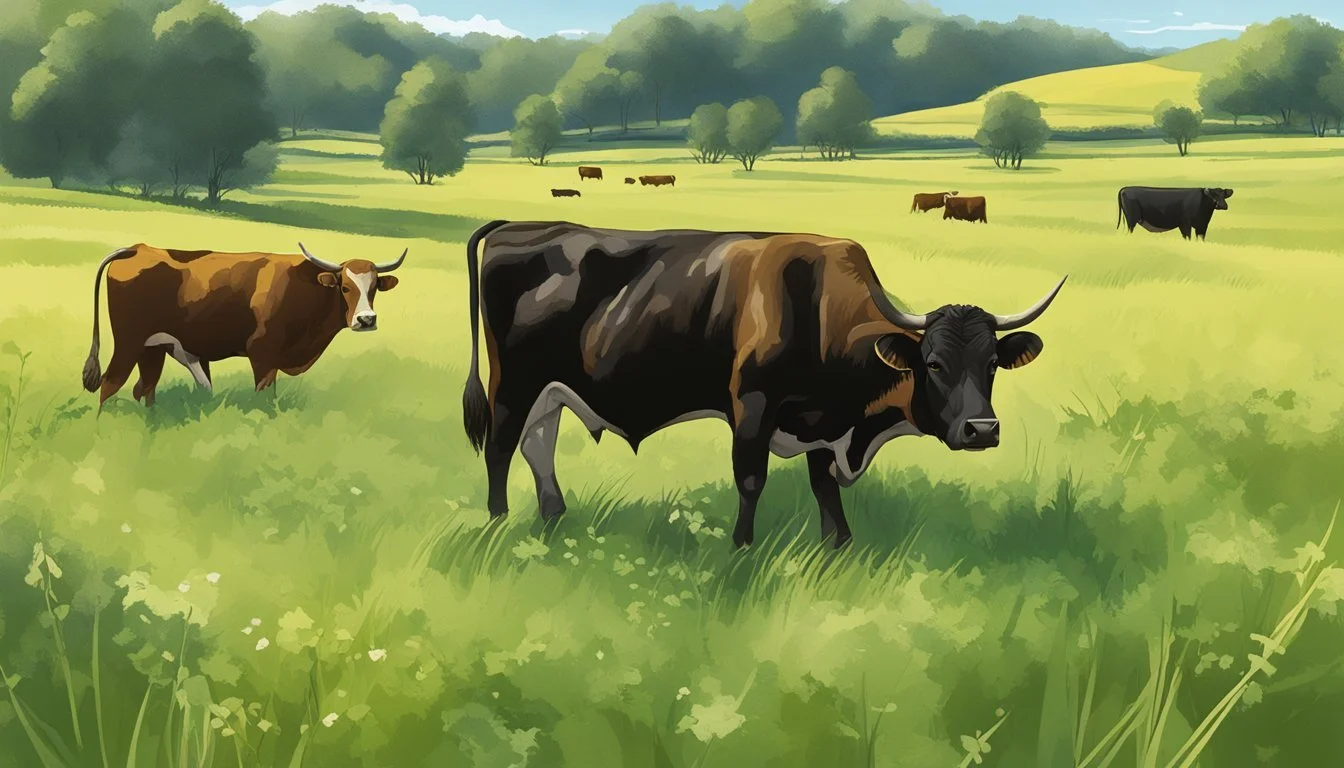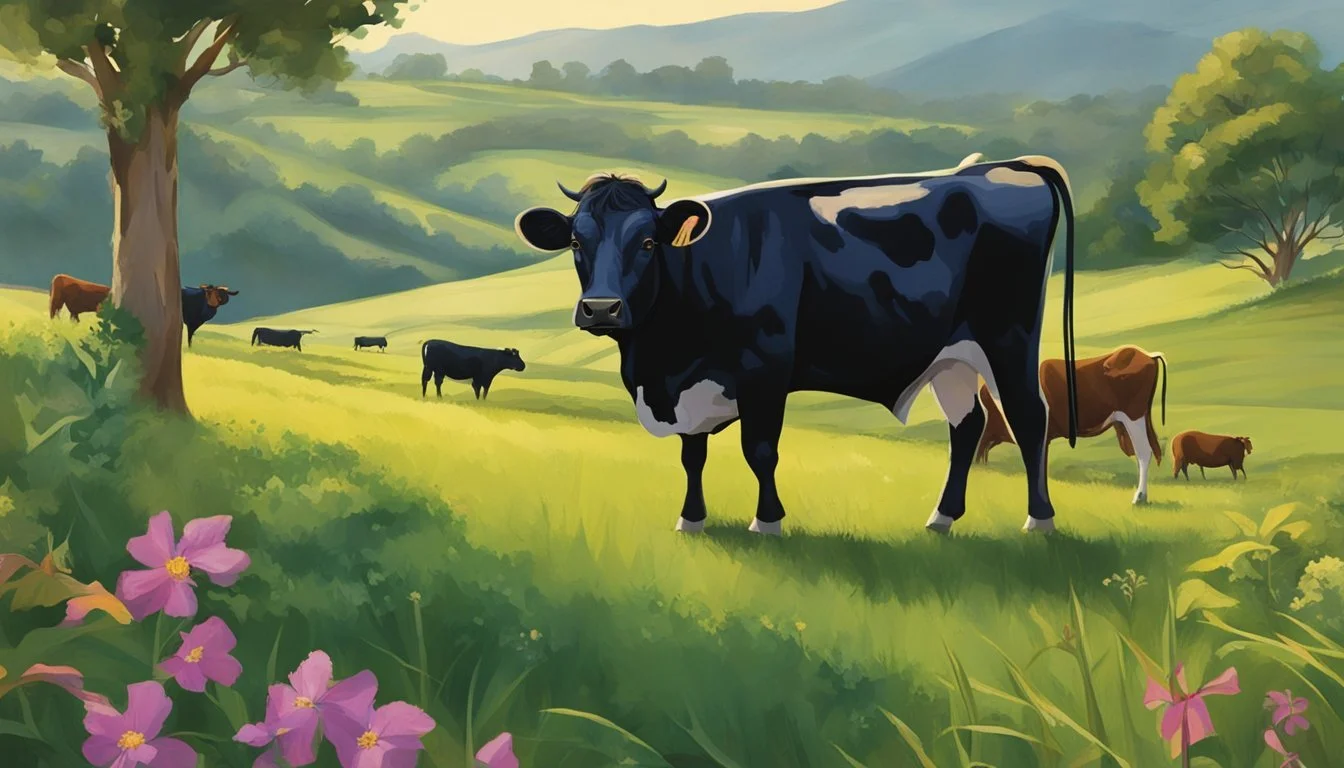The Role of Dexter Cattle in Biodynamic Farming Systems
Integrating Livestock for Sustainability
Dexter Cattle are increasingly recognized for their role within biodynamic farming systems. Originating from Ireland, these small, hardy cattle are known for their ability to thrive in diverse climatic conditions, making them a suitable choice for biodynamic farms that emphasize a holistic approach to agriculture. Their versatility as a dual-purpose breed, efficiently providing both milk and meat, aligns well with the philosophy of biodynamic farming, which values self-sufficiency and sustainability in food production.
Biodynamic farming is an advanced form of organic agriculture that integrates ecological, social, and economic sustainability. It involves treating the farm as a self-sustaining ecosystem without relying on external chemical inputs. The utilization of livestock, such as Dexter Cattle, plays a critical role in this system. The cattle contribute to soil fertility through their manure, which is often used in biodynamic preparations to enhance soil health and stimulate plant growth.
Sustainability is at the core of biodynamic farming, where the aim is to create a closed-loop system that recycles nutrients and maintains ecological balance. Dexter Cattle's modest size and efficient feed conversion make them well-suited to this aspect, as they require less land and food resources compared to larger cattle breeds. The integration of Dexter Cattle into a biodynamic farm contributes to the overall goal of creating a diversified and resilient agricultural system that can sustainably produce food in harmony with the environment.
Historical Context
The historical backdrop of Dexter cattle and the development of biodynamic agriculture are essential to understanding their role in sustainable farming systems.
Origin of Dexter Cattle
Dexter cattle originated in Ireland and were first documented in the early 19th century. This small breed is a descendant from the predominantly black cattle of the early Celts and is known for its hardiness and adaptability. The breed’s utility and characteristics gained formal recognition with the establishment of the English Kerry and Dexter Cattle Society, which later became known as the Dexter Cattle Society in 1924. According to society records, the Dexter herd book had listed 986 bulls and 3,896 cows by 1926.
Development of Biodynamic Agriculture
Biodynamic agriculture is rooted in Europe and stemmed from the Anthroposophical teachings of Rudolf Steiner in the early 20th century. It encompasses a spiritual-ethical-ecological approach to farming, aiming to create a self-sustaining ecosystem through specially prepared biodynamic composts and field sprays. These biodynamic preparations are intended to enhance soil health and vitality, emphasizing a harmonious relationship between farming practices and cosmic forces. This approach has grown since its inception, now practiced on more than 5,500 farms worldwide.
Biodynamic Farming Principles
In biodynamic farming, principles revolve around creating a self-sustaining ecosystem that emphasizes soil health and vitality through specific practices and preparations. These methods are designed not only to cultivate crops but also to nourish and regenerate the earth.
Biodynamic Preparations and Practices
Biodynamic farming employs unique preparations made from minerals, plants, and animal manure, which are intended to enhance soil quality and stimulate plant growth. These preparations, numbered 500 to 508, are applied to fields and compost to organize the energetic forces within the farm ecosystem. For instance:
Preparation 500: Horn Manure, enhances soil structure and root growth.
Preparation 501: Horn Silica, influences light metabolism in plants and improves resilience.
The timing of these applications follows an astronomical sowing and planting calendar to work harmoniously with cosmic rhythms, supporting robust biodynamic food production systems that yield nutritious and vital foods.
Compost Development in Biodynamic Systems
Compost acts as the cornerstone of soil fertility in biodynamic farming practices. Biodynamic systems place a significant emphasis on creating high-quality compost that features a balance of nitrogen, carbon, and other nutrients. This process imparts vitality to the soil, fostering a living microbiome that benefits plant growth.
Biodynamic compost utilizes:
Crop residues
Animal manures
Biodynamic preparations (such as Preparation 502 to 507, which include yarrow, chamomile, stinging nettle, oak bark, dandelion, and valerian)
This approach transforms organic matter into rich humus, enhancing soil structure and water retention, and leading to increased soil quality and health, which in turn supports more resilient farming systems and the cultivation of high-quality biodynamic food.
Role of Dexter Cattle in Biodynamics
Dexter cattle, a small and resilient breed, serve a pivotal role in the biodynamic farming system. They enhance biodiversity, contribute to soil and plant health, and bolster ecosystem resilience.
Contribution to Biodiversity
Dexter cattle, due to their smaller size and diverse color variations—including black, red, and dun—add genetic variety to a farm's livestock population. Their adaptability allows them to thrive in varying climatic conditions, which is instrumental in maintaining genetic diversity within cattle species.
Advantages to Biodiversity:
Adds to the genetic pool
Promotes species adaptation and survival
Benefit to Soil and Plant Health
The nutrient-rich manure of Dexter cattle is a key component in biodynamic farming. Their manure acts as a high-quality organic fertilizer, enriching the soil microbial life and fertility. Therefore, this improves the health and productivity of the plants cultivated.
Soil and Plant Health Benefits:
Manure Composition: Enriches soil with nutrients
Soil Fertility: Promotes robust plant growth
Influence on Farm Ecosystem Resilience
The integration of Dexter cattle into biodynamic farms enhances the resilience of the farm ecosystem. They contribute by providing manure for compost preparations and supporting cycles of regeneration within the farm.
Ecosystem Resilience Factors:
Compost Preparations: Fosters closed-loop nutrient systems
Regenerative Practices: Encourages sustainable land use
Environmental Impacts
In the realm of biodynamic farming, Dexter cattle contribute to a more environmentally efficient agricultural system. Their smaller size and foraging habits have distinct implications for methane emissions and conservation efforts.
Reduction of Methane Emissions
Dexter cattle, a hardy breed adapted to diverse climates and pasture types, exhibit efficient feed conversion that can lead to reduced methane production compared to larger breeds. Methane emission is a critical environmental issue because methane has a global warming potential 28-36 times greater than CO2 over 100 years. Dexter cattle mature quickly and have a shorter lifespan on the farm, which means they spend less time emitting before reaching market weight.
Key Facts:
Global Warming Potential of Methane: 28-36 times greater than CO2
Feed Conversion: More efficient in Dexter cattle
Lifespan: Shorter, leading to reduced cumulative emissions
Use of Local Breeds for Conservation
Dexter cattle serve as an example of the use of local breeds in conservation. They are valued for their adaptability and as a genetic resource, preserving biodiversity in agricultural systems. Utilizing local breeds like Dexters aligns with biodynamic farming principles by promoting genetic resources that are well-suited to the local environment, thereby lowering the overall environmental footprint of the farm.
Benefits to Conservation:
Enhances biodiversity within the farming system
Preserves genetic resources beneficial to future breeding programs
Lowers the environmental footprint through adaptation to local climates and terrains
Genetics and Breeding
The genetic framework of Dexter cattle plays a pivotal role in biodynamic farming systems, where targeted breeding strategies emphasize both genetic diversity and the alignment of traits with sustainable agricultural practices.
Promoting Within-Breed Diversity
In biodynamic farming, genetic diversity is essential to maintain a resilient Dexter cattle population. Genetic selection here is focused on preserving a wide pool of genetic traits to prepare the breed for various environmental stressors and to sustain overall herd health. Strategies include:
Monitoring genetic variability: Regular assessment of the genetic makeup within the breed ensures a diverse gene pool is maintained.
Conservation breeding: Protection of rarer genes and alleles within the Dexter breed to prevent loss of unique characteristics.
Selective Breeding in Dexter Cattle
Selective breeding in Dexter cattle is geared towards enhancing traits that are beneficial for biodynamic farming systems, such as hardiness, forage efficiency, and milk quality. Key elements of selective breeding include:
Breeding Goals: Clearly defined objectives that focus on traits like temperament, size, and milk yield to support the sustainability and productivity of biodynamic farms.
Artificial Insemination (AI): The use of AI enables the introduction of desired genetic traits from a wider gene pool and accelerates genetic improvement without compromising the breed's integrity.
Animal Welfare and Husbandry
In biodynamic farming systems, like those incorporating Dexter cattle, the paramount focus is the ethical treatment and well-being of livestock. Dexter cattle's role is scrutinized through the lenses of both welfare and husbandry, ensuring that their care aligns with biodynamic principles.
Ethical Care and Management
Biodynamic farming places high importance on ensuring that Dexter cattle—and all animals—are treated with the utmost care. They are not merely production units but are considered integral to the farm's ecosystem. Actions such as avoiding harsh handling methods like electric prods and sticks are prohibited, as these practices can negatively affect the welfare and behavior of cattle. Instead, farmers employ management practices that respect the animals' innate behaviors, needs, and well-being.
Housing: Suitable for their size and behavior.
Social Structure: Maintaining natural herd dynamics.
Handling: Gentle and stress-free interactions.
Feed Efficiency and Animal Health
Feed efficiency is crucial for sustaining the health of Dexter cattle in a biodynamic context. Health and nutrition are interconnected, as a properly fed animal is typically healthier and less prone to disease. Biodynamic farming emphasizes the use of organic feed and considers the nutritional needs of cattle to ensure optimal health and productivity.
Diet: Natural, organic, and species-appropriate.
Health Checks: Regular monitoring for early detection of potential health issues.
Veterinary Care: Prompt and holistic treatments aligned with biodynamic principles.
Farmers continuously work to balance the dietary needs of their cattle with ecological sustainability, aiming to maintain a system that supports the health of the animals as much as it does the land.
Economic and Production Factors
Dexter cattle contribute significantly to the biodynamic dairy industry through their dual-purpose nature for both milk and meat production. Their feed efficiency makes them well-suited for smaller farms committed to sustainable agricultural practices.
Contribution to Sustainable Dairy Industry
Dexter cattle are increasingly recognized for their role in sustainable dairy operations. As a heritage breed, Dexters require fewer inputs than larger dairy breeds, yet still produce a considerable amount of milk relative to their size. Sustainable agriculture practices benefit from these cattle as they efficiently convert feed into milk, maintaining the balance of production with the environment. Additionally, their smaller size reduces soil compaction, benefiting the farmland.
Production Efficiency vs. Financial Competitiveness
The financial competitiveness of organic agriculture often hinges on production efficiency. Dexter cattle excel in this aspect due to their lower maintenance needs and adaptive versatility. When comparing milk production rates, Dexters may produce less milk than larger dairy breeds; however, their milk is higher in fat and protein content, which can command a higher market price. In biodynamic farming systems, where the emphasis is on quality and ecologically sound practices, the financial model favors Dexters due to lower costs for upkeep and potential for premium pricing on their dairy products.
To summarize, Dexter cattle provide a robust option for farmers focusing on economic sustainability without compromising production volume and quality. Their presence in the biodynamic farming system serves to bolster both the economic viability and ecological soundness of operations within the dairy industry.
Integrating Dexter Cattle into Diverse Farming Systems
Dexter cattle can enhance the sustainability of diversified farming systems through their adaptability and utility. These small breed cattle fit well into biodynamic approaches due to their efficient feed conversion and positive environmental impact.
Agroforestry and Dexter Cattle
Agroforestry, the practice of integrating trees and shrubs into crop and animal farming systems, benefits from the inclusion of Dexter cattle. The cattle contribute to the system by providing:
Grazing management: They control undergrowth without damaging young trees due to their small size.
Soil fertility: Their manure serves as a natural fertilizer, enriching the soil with nutrients.
Farmers practicing agroforestry find Dexter cattle to be particularly valuable as they can forage in smaller sections of woodland, promoting diversification of the habitat. This leads to agroecological benefits, such as increased biodiversity and ecological balance.
Crop Rotation and Natural Fertilizers
Incorporating Dexter cattle into crop rotation systems can improve soil health and reduce dependency on artificial fertilizers. Aspects of this integration include:
Nutrient cycling: Their manure adds organic matter to the soil, enhancing its structure and water retention.
Green manure: Dexter cattle can graze on cover crops, which are then trampled and decomposed to act as green manure, further contributing to soil fertility.
By rotating Dexter cattle across different pastures, the cattle aid in breaking pest and disease cycles, supporting the principles of crop rotation. Their presence helps maintain the health and productivity of the land, leading to a more resilient agricultural system.
Research and Development
In the realm of biodynamic farming, targeted research and the application of modern technologies are essential to evaluate the efficacy and sustainability of farming systems, specifically how they affect breeds like Dexter cattle.
Studying Biodynamic Effects on Dexter Cattle
Researchers have focused on the impact of biodynamic farming practices on the health and productivity of Dexter cattle. Dexter cattle, a small breed known for its hardiness and dual-purpose utility for both milk and meat, serve as an integral part of biodynamic systems. Studies assess factors such as milk yield, meat quality, and overall animal health. Sustainable farming systems prioritize these aspects, aiming to create a harmonious balance between land use and animal welfare. By monitoring variables like growth rates and feed efficiency within biodynamic protocols, scientists can determine the viability of these practices for small-scale farmers.
Innovation Through Modern Technologies
The implementation of modern technologies in biodynamic farming allows for precise data collection and analysis, in turn fostering innovations that enhance sustainability. Technologies such as GPS tracking and RFID tags provide data on cattle's grazing patterns and overall behavior. Biodynamic practitioners leverage this data to refine agricultural methods, ensuring that they align with the principles of sustainable farming systems. Additionally, drones equipped with sensors can evaluate pasture health, contributing to informed decision-making regarding crop rotation and grazing schedules. Such technologies aid in minimizing the ecological footprint while maintaining productivity.
Consumer Perspectives and Market Dynamics
The consumer perspective on Dexter cattle in biodynamic farming systems significantly influences the market dynamics for biodynamic products, with a particular focus on dairy quality and the supply chain that supports it.
Demand for Biodynamic Products
Consumers are increasingly seeking products labeled as biodynamic due to their perception of higher food quality and sustainable production methods. Biodynamic agriculture integrates organic farming methods with a specific philosophical approach to land stewardship, which includes soil health, animal welfare, and cosmic forces. The demand for biodynamic products, including milk from breeds like Dexter cattle, is seen as a response to a growing consumer interest in ethical and ecological farming practices.
Increase in Demand: There is a notable uptick in consumer demand for biodynamic foods, where buyers are willing to pay a premium for products aligned with their values.
Supply Chain Management: Effective supply chain management ensures the availability of biodynamic products, which can be challenging due to the stringent standards required for biodynamic certification.
Quality of Organic vs. Biodynamic Dairy
Biodynamic and organic dairy products are both perceived as high-quality options compared to conventionally farmed dairy; however, biodynamic dairy from Dexter cattle often garners a unique niche. These differences are recognized by consumers in terms of both taste and health benefits.
Biodynamic Food Quality: Biodynamic farming's rigorous methods often result in milk that consumers believe is nutritionally superior and more flavorful due to the diverse and rich pastures these cattle graze on.
Consumer Preferences: While organic dairy is widely accepted for its absence of artificial inputs, biodynamic dairy adheres to more holistic agricultural practices that resonate with a segment of consumers looking for the next level in food quality and sustainable agriculture.
Through their purchasing power, consumers are influencing market trends, nuding producers to integrate more biodynamic principles into their dairy farming practices.
Future Outlook
Dexter cattle's adaptability and smaller size could play a significant role in the evolution of biodynamic farming practices. Their contributions to resilience and diversity within farming systems can be assessed within the following subsections, with potential impacts on global food security.
Challenges and Opportunities
Resilience: In the context of biodynamics, Dexter cattle can enhance the resilience of agricultural systems against environmental fluctuations. They require less feed, manage more effectively on rough terrain, and contribute to the cyclical sustainability of the farm ecosystem.
Diversity: These cattle add genetic diversity to farm livestock, which is crucial for adapting to future environmental changes and unexpected challenges. Their presence in a biodynamic system contributes to robust soil health, aiding rewilding efforts.
Peer-Reviewed Journals: Literature from peer-reviewed journals suggests a growing interest in biodynamic practices' long-term viability, where Dexter cattle could be a focal point due to their minimal environmental footprint.
Predictions for Global Trends in Biodynamics
Global Food Security: Proponents believe that incorporating Dexter cattle into biodynamic systems may help address global food security through more efficient land use and sustainable meat production.
Rewilding: As biodynamic farming gains traction, Dexter cattle's grazing patterns are predicted to facilitate rewilding efforts, thus promoting biodiversity and restoring ecological balance.
Through detailed analysis and application of such sustainable practices, the integration of Dexter cattle in biodynamic farming could address some of the most pressing agricultural challenges of the future.








